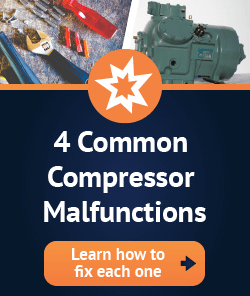Refrigerant floodback is a serious problem that can quickly cause mechanical damage. In the worst case, even a brief episode of floodback could lead to catastrophic failure of your commercial compressor. Even though some newer compressors are designed to resist floodback to some degree, it’s still important to know what to do.
As with most compressor malfunctions, the best way to cut the risk of refrigerant floodback is to have a regular and fully documented compressor maintenance program in place. That said, there are some steps you can take to be more proactive about refrigerant floodback and fix it faster if it does happen.
What Is Refrigerant Floodback in a Screw Compressor?
What is refrigerant floodback? Not to be confused with migration, this refers to any condition where liquid refrigerant, rather than refrigerant vapor, is returned to the compressor during a running cycle. Newer compressors may be able to withstand smaller amounts of floodback, but the underlying issue needs to be addressed.
Screw compressors are less prone to refrigerant floodback than many other models, but you should still be familiar with the procedure to identify and respond to it. Prompt attention means the compressor is far less likely to develop long-term problems or require replacement before its time.
During floodback, the oil within the unit is diluted with refrigerant, making it unable to provide lubrication for the load-bearing surfaces. Precisely how this affects the compressor varies based on the architecture in use:
Refrigerant Floodback in Open Drive Compressors
In an open drive compressor, the liquid will wash the oil away from pistons and cylinder walls throughout the suction stroke. That leads to repeated friction and wear throughout the compression stroke. Prolonged floodback could require you to replace the pistons.
During a visual inspection, you might notice symptoms such as:
- Dry and/or worn-out looking pistons and cylinders
- No evidence of compressor overheating
Refrigerant Floodback in Refrigerant Cooled Compressors
For refrigerant-cooled compressors, the liquid dilutes the oil in the crankcase. Refrigerant-rich oil is pumped to the rods and bearings via the crankshaft until it begins to boil off. As boil-off continues, there is no longer a sufficient amount of lubricant for the bearings located furthest from the oil pump.
With a refrigerant-cooled commercial compressor, the center and rear bearings will appear worn and might seize up in operation. You might notice a dragging rotor or shorted stator along with a progressively worn crankshaft. Broken or worn-out rods are common. Piston rings might also have signs of wear.
How to Fix Refrigerant Floodback in a Commercial Screw Compressor
Correcting refrigerant floodback in a commercial screw compressor consists of three steps:
- Maintain the right level of evaporator and compressor superheat
- Correct any abnormally low load condition
- Optionally, consider a suction accumulator to stop the uncontrolled liquid return
The Carrier Paragon 06T Compressor Is Designed to Resist Floodback
If floodback is a concern in your operating environment, you might want to consider a commercial screw compressor specially designed to prevent floodback and be resilient if it occurs. The Carrier Paragon line provides an extra level of protection while delivering the performance and efficiency you want.
The Carrier Paragon 06T incorporates a twin screw design that has no suction or discharge reed valves. That makes it more tolerant to liquid floodback than most comparable screw or reciprocating compressors on the market. And that’s only one innovation among many that make it particularly effective.
With a Carrier Paragon 06T, you can look forward to:
- A compact footprint with a compressor approximately 15% smaller and lighter than reciprocating units
- Fewer compressors per rack and smaller mechanical rooms for your site thanks to high specific output
- Superior maintenance due to a far lower number of moving parts, reduced noise, and low vibrations
- Mechanical subcooler support on low, medium, and high temperature applications, raising efficiency
All in all, the Carrier Paragon 06T compressor can deliver up to 50% higher capacity versus the reciprocating compressors it is often compared to. And with help from a commercial compressor remanufacturer, you can rest assured the Carrier compressors you need are available with no waiting.
Compressor Remanufacturing Makes It Easy to Enjoy the Benefits of the Carrier Paragon 06T
Floodback will be one less worry on your mind with the Carrier Paragon line. Remanufacturing is the fastest and most cost-effective way to source one. With a remanufactured commercial compressor, you get a unit ready for another eight to ten years of work at a fraction of the time and cost of a unit from the OEM.
In remanufacturing, an existing compressor core is used as the basis of your compressor. It is fully cleaned out, inspected, and updated with replacement parts. All functions are progressively tested and documented before the equipment is released to you. It’s an increasingly popular way to make Carrier compressors an even better value.












